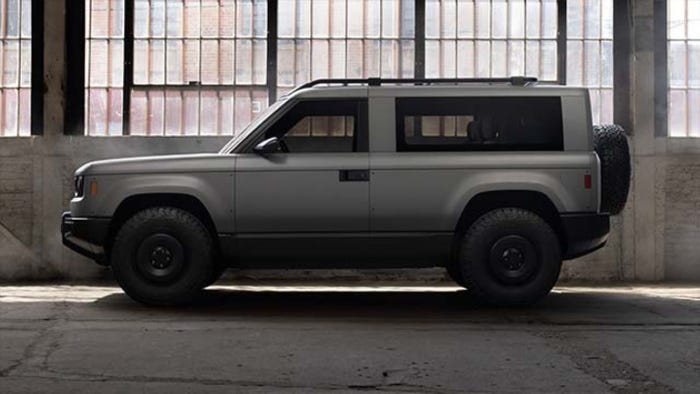In a market dominated by high-end electric vehicles, Slate Auto emerges as a possible game-changer. Never mind Chinese automaker BYD coming into the U.S. with its cheap BEVs. Slate could throw a major scare into legacy automakers from within the U.S.
Backed by Jeff Bezos and other prominent investors, this Michigan-based startup unveiled its first vehicle – a minimalist, highly customizable electric pickup truck priced at $25,000 before incentives – on April 24. With federal tax credits, which may or may not stay in place under the Trump Admin., the price drops to under $20,000, making it the most affordable EV in the U.S.
A New Approach to EVs
Slate’s strategy deviates from the luxury-first models of companies like Tesla and Rivian. The base model, dubbed the “Blank Slate,” is intentionally stripped down – featuring manually operated windows, no infotainment system or even a radio, and an unpainted gray composite body. This simplicity allows for cost savings and offers buyers the freedom to customize their vehicles with over 100 optional accessories, including a kit to convert the truck into a 5-passenger SUV.
While most automakers are chasing an affordable BEV with 300 miles of range, The Slate pickup/SUV has a range of 150 miles (241 km). That may not seem like much, but the company, as well as third-party sources, says most vehicle owners drive less than 40 miles (64 km) a day. Most consumers, though, have been reluctant to buy BEVs with range less than 200 miles (322 km).
Related:Volkswagen Keeps 2025 GTI for the U.S. After Deleting Standard Golf
Industry analysts are still grappling with the business model. Ryan Brinkman, automotive equity analyst at JPMorgan, remarks: “I struggle to think of anything analogous in the history of the automotive industry.” If Amazon’s mega-wealthy founder Bezos was not behind the company, the audacity of the strategy would probably not garner as much attention.
The vehicle and brand could appeal to the legions of buyers balking at the increasingly rising prices of new vehicles. The average transaction price for a new car in the U.S. last year, says Kelley Blue Book, was $49,740. It could also appeal to buyers who have soured on menu bloat – the larding-on of communications, ADAS, telematics and intrusive and often poorly executed active safety tech. The high cost of repair and insurance of new tech-laden vehicles could be another demand driver for Slate vehicles.
The average price of full insurance coverage in the U.S. is $2,685, according to Bankrate, with coverage prices for many drivers and vehicles well above that level.
Related:Coming To A Street Near You: Slate Auto EVs
Jeremy Snyder, Slate’s chief commercial officer and a former Tesla executive, emphasizes the company’s mission: “The auto industry has been so focused on autonomy and technology in the vehicle, it’s driven prices to a place that most Americans simply can’t afford.”
Purchase prices aren’t the only part of vehicle ownership stinging buyers. Consumers now spend an average of $838 per repair, according to Kelley Blue Book. This reflects a significant increase over the past decade. For instance, in 2023, vehicle repair costs rose 17% compared to the previous year.
The escalation in both insurance premiums and repair costs can be attributed to factors such as increased vehicle complexity, higher labor rates and more expensive parts – all factors Slate is countering by going simpler and cheaper without sacrificing safety.
Targeting Underserved Demographics
Slate’s affordable EV is poised to resonate with two key demographics: Generation Z and income-restricted retirees.
Gen Z is a tech-savvy, environmentally conscious cohort facing significant financial constraints. The Blank Slate’s low entry price and DIY customization options align with Gen Z’s values of sustainability and personalization. The vehicle’s modular design allows for upgrades over time, accommodating budgetary limitations, thus saving buyers interest payments on loans for vehicles twice as expensive.
Related:Dealer Shortage Delays Nio European Firefly
At the other end of the demographic spectrum, fixed incomes among retirees make high vehicle costs prohibitive for many. The Slate Truck offers an affordable, low-maintenance transportation solution.
Slate’s business model challenges traditional automotive norms by emphasizing affordability, customization, simplicity and reducing overall cost of ownership. Insurance companies have yet to weigh in, but with less tech to replace after accidents it’s likely that insurance rates would be lower than those of comparable legacy vehicles.
Technology Shift
Slate is not going with lithium-iron-phosphate (LFP) cells but rather nickel manganese-cobalt (NMC) batteries. Why? Slate executives say it would’ve been challenging to comply with the federal EV tax credit’s battery-sourcing requirements while using LFP.
The incentive isn’t available to buyers of just any EV; they must be produced in North America with enough North American content. Slate is opening a production plant in North America. Slate is expected to announce a plant in Indiana in the coming weeks, though the company has not yet confirmed that location.
By 2029, 100% of a qualifying vehicle’s battery components must be made in North America. By 2027, 80% of an EV battery’s critical minerals must be recycled in North America, come from the U.S. or come from a country with which the U.S. has a free-trade agreement.
Production Profitability
Slate’s Blank Slate pickup is intentionally designed with simplicity to minimize production costs. Besides eliminating non-essential features such as infotainment systems and power windows, Slate reduces manufacturing complexity and expenses. The vehicle is available in a single gray color molded into its composite body panels, avoiding the need for a costly paint shop.

While the base model is spartan, and the basic design is somewhat retro, Slate anticipates generating additional revenue through a wide array of optional accessories.
Direct Sales
Slate plans to sell its vehicles directly to consumers, bypassing traditional dealership networks. This approach not only reduces costs associated with intermediaries, but the company also is developing “Slate University,” a platform to support customers in customizing and maintaining their vehicles.
